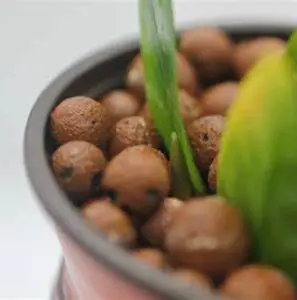Contents
Using a technique called semi hydroponics, ‘semi hydro,’ or hydroculture, plants are grown without soil, bark, or peat moss. A semi hydroponic system uses an inorganic, inert, and solid growing medium instead of true hydroponics. The roots of the plant are suspended in a liquid solution as the growing medium. The main material used (LECA, or clay aggregate) is a highly absorbent, lightweight, extremely porous, and low-density material.
As opposed to true hydroponics, semi – hydroponics utilize capillary action rather than pumps. The wicking action of the media allows nutrients and water to be pulled from a reservoir into the roots, providing them with a constant supply of nutrients and water.
LECA: What is it?
LECA (Lightweight Expanded Clay Aggregate), also known as expanded clay balls or expanded clay, is a semi-hydroponic/hydroculture growing medium crushed to a fine aggregate. A rotary kiln-based process is used to heat clay to extremely high temperatures to produce clay pebbles. Expansion of the clay by the gases produces thousands of tiny air pockets or pores, which look like honeycombs. These aggregates can vary in size and have hard outer shells and porous inner structures that make them dense and strong.
Features of LECA that can be utilized in semi-hydroponic systems
 Capillary Properties: LECA can continuously draw water and nutrients upward to its roots through its capillary ability.
Capillary Properties: LECA can continuously draw water and nutrients upward to its roots through its capillary ability.- Chemically Inert Medium: LECA provides a neutral pH, which is achieved by its chemical inertness.
- Inorganic Nature: An inorganic medium like LECA is impervious to decay. Combined with its strength and durability, it holds its structure and does not degrade or compact over time, thereby maintaining a steady supply of air and oxygen to the roots. Plants grown in compacted soil or waterlogged soil can suffer from root rot and disease due to the lack of oxygen.
- Porous Structure: Many of LECA’s air pockets and spaces provide an abundance of air and oxygen to the plant’s roots, in addition to the granular air spaces. To promote healthy root growth, your root zone should be oxygenated. House plants with healthy roots are less likely to develop disease and root rot.
- Strength and Durability: Because LECA has both strength and durability, it can be utilized instead of potting soil to support and stabilize plants. Furthermore, its strength and durability make it suitable for reusing time and time again without deteriorating or compacting over time.
LECA is an ideal semi-hydronic growing medium because of the properties listed above. Using LECA’s capillary/wicking ability will continuously supply clean water and nutrients to the roots. At the same time, its porous structure will maintain an airy and oxygen-rich environment necessary for healthy root development. Moreover, because LECA is strong and made of inorganic materials, you can reuse it endlessly without losing its strength or becoming compacted.
Basic Semi Hydroponic Setup
You can use various semi-hydroponic set-ups, but the simplest and most basic is what I like to refer to as the ‘inner/outer pot’ method. As an alternative, the plant is grown in a deep saucer with no drain holes or in a shallow pot with drainage holes at the bottom. Essentially, the outer pot functions as a nutrient reservoir (plain water diluted with hydroponic nutrients).
The roots are supplied with nutrients and water through the drainage holes and the LECA that runs through them. Plant roots should be planted about 1/3 of the height of the waterline above the nutrient reservoir when full. You can run water through the inner pot and out of the drainage holes periodically to flush out salt and plant waste; then, you can top up fresh nutrient solution in the reservoir.
Basic Componentes You’ll Need
- You will need an inner pot made of plastic with drainage holes (so you can place your plants inside). The pots have drainage holes made of hard, durable plastic, and they have numerous holes that allow for easy drainage while also being small enough for the roots not to fall out. In addition to the nursery pot, you could use LECA pieces nearer the drainage holes to fill in the areas between the drainage holes. Just make sure the nursery pot has been cleaned and sanitized before use.
- To hold the reservoir of nutrients in a pot or saucer without drainage holes (outer pot). With or without drainage holes, any decorative outer pot will do. Saucers are great for beginners since it is easier to measure the waterline height (if you prefer opaque outer pots, you can mark the reservoir height on the outer pot with tape).
- Growing media – LECA. You can usually find this at your local hydroponic store.
- Hydroponic Nutrients
- A pH meter or pH testing kit
- pH stabilizers – pH up and pH down

